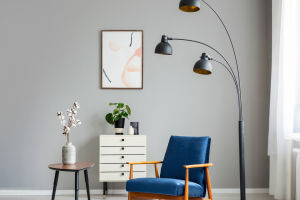
Have you ever moved into a new place or simply wanted to switch up the vibe in your current space, but had no idea how to arrange the furniture?
Well, don't worry, Lykkers! Whether it's to make the room feel larger, more inviting, or simply more functional, the way you arrange your furniture can make a world of difference. Here are six essential tips that every interior designer swears by to help you get it just right.
1. Traffic Flow – The Pathway to Comfort
The first and most important rule when arranging your furniture is ensuring smooth traffic flow. We all know how frustrating it is when you need to get from one point to another but have to navigate around bulky furniture. The idea is to allow for clear, unobstructed pathways. This not only makes moving through the space easier but also keeps the space from feeling cramped.To make sure you're creating these smooth paths, try to maintain the following distances:
• 45 cm for sideways movement
• 55-60 cm for moving directly in front of furniture
• 110-120 cm for two people to comfortably pass each other
Keep in mind, you should always leave enough room for people to walk, pull out chairs, or engage in daily activities without feeling crowded. Don't overcrowd the room with unnecessary pieces. In small spaces, try grouping furniture along one wall to give the illusion of more open space.
2. Line of Sight – Making the Room Feel Bigger
Ever noticed how a room feels more spacious when you have a clear line of sight? This is all about removing visual obstacles. Imagine sitting on a sofa with a huge wall in front of you, or worse, an awkward divider cutting off your view—doesn't sound comfortable, right?To avoid this, consider keeping the furniture low and open, so you can see across the room. If you must use tall furniture, place it in corners or against walls. The goal is to reduce the sense of confinement. If you can, ensure that sitting in one part of the room allows you to see a beautiful view or a calming green plant.
3. Space – The Right Amount Matters
When you have a small room, it's tempting to fill every inch with furniture. However, overloading the space with too many pieces can make it feel cramped and uncomfortable. On the flip side, if your room is too big and you don't fill it enough, it might feel empty and uninviting.For ideal space utilization, aim for furniture to occupy no more than a third of the total room area. For example, in a 10 square meter room, try to keep the furniture within 3-4 square meters. If you want to maximize space in a smaller room, keep the furniture unified in one corner or along one wall. For a truly open feel, use floor seating or low-profile furniture.
4. Cohesion – Create Harmony in Your Space
Ever walked into a room where the furniture seemed to clash in terms of style, size, or color? The result is often a room that feels disorganized and uncomfortable. To avoid this, choose furniture with similar styles and colors to create harmony.When you're placing furniture of different heights or shapes, consider using simple solutions like curtains or screens to cover any awkwardly positioned pieces. You can also unify different pieces by aligning them in a straight line, ensuring that the highest items are at the back to create a more balanced feel.
5. Focal Points – Guide the Eye
Every room needs a visual anchor, a place for the eyes to naturally settle. In living rooms, this could be a beautiful painting or an attractive plant; in the dining area, perhaps a striking chandelier or a feature wall.When arranging your furniture, make sure the focal point is aligned with where people are most likely to sit. For example, place the sofa in such a way that it faces an interesting piece of artwork or a lovely outdoor view. A well-placed focal point can make your room feel more elegant and balanced.
6. The Near-Far Effect – Play with Depth
Want to make a small room look larger? Use the near-far effect! This trick involves creating depth in your space by placing lower-profile furniture closer to you and allowing taller pieces to be placed further away. This layout mimics the perspective of a painting, where objects appear smaller the farther they are.You can enhance this effect by leaving a clear path from the entrance to the farthest wall or adding a light-colored feature, like a neutral painting or light-toned walls. This approach creates the illusion of a more spacious and inviting room.
There you have it, Lykkers! With these six tips, you'll be well on your way to creating a space that's both comfortable and visually stunning. Whether you're moving into a new home or just refreshing your current one, these simple strategies will help transform any room into a stylish and functional haven. Happy decorating!


